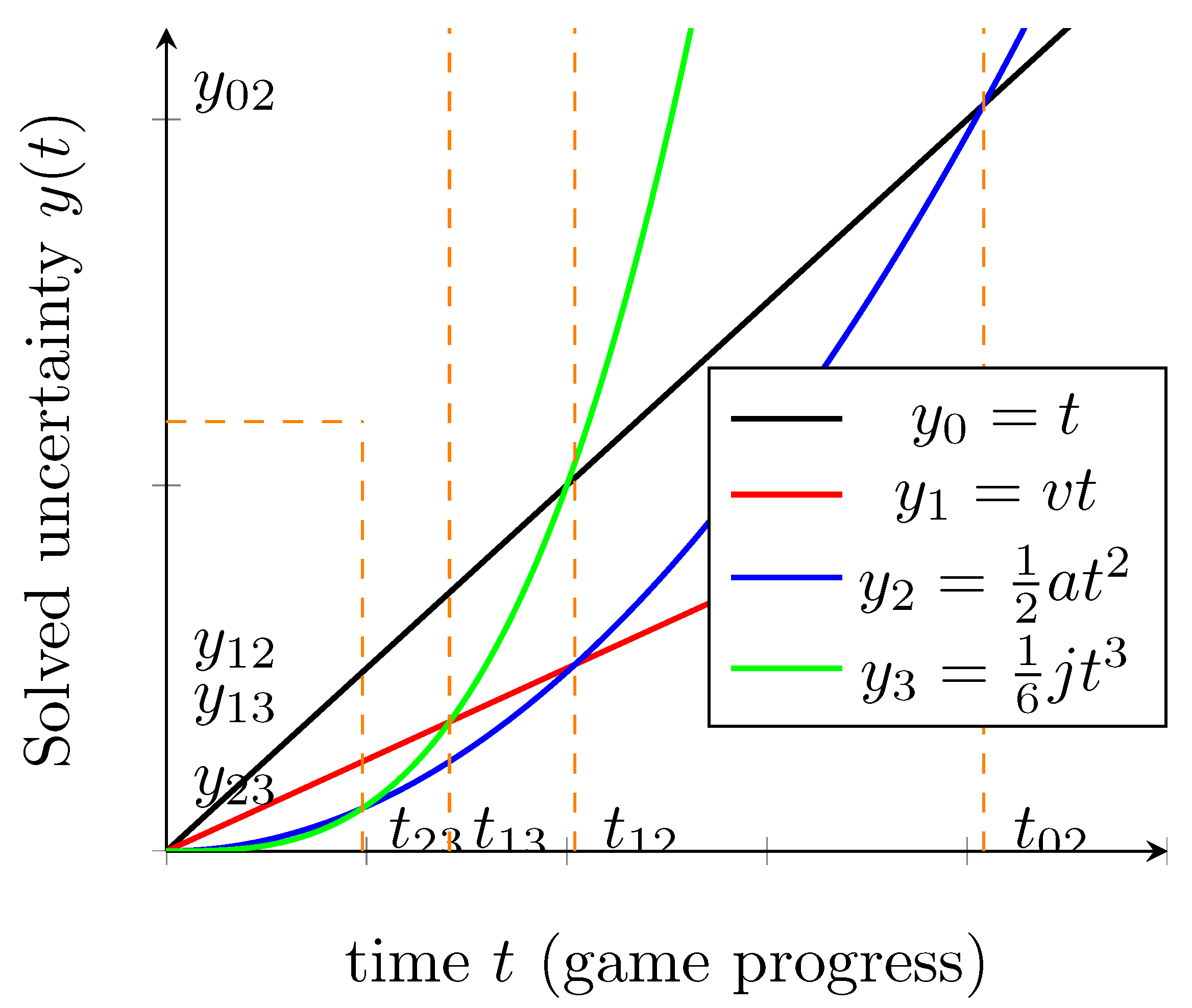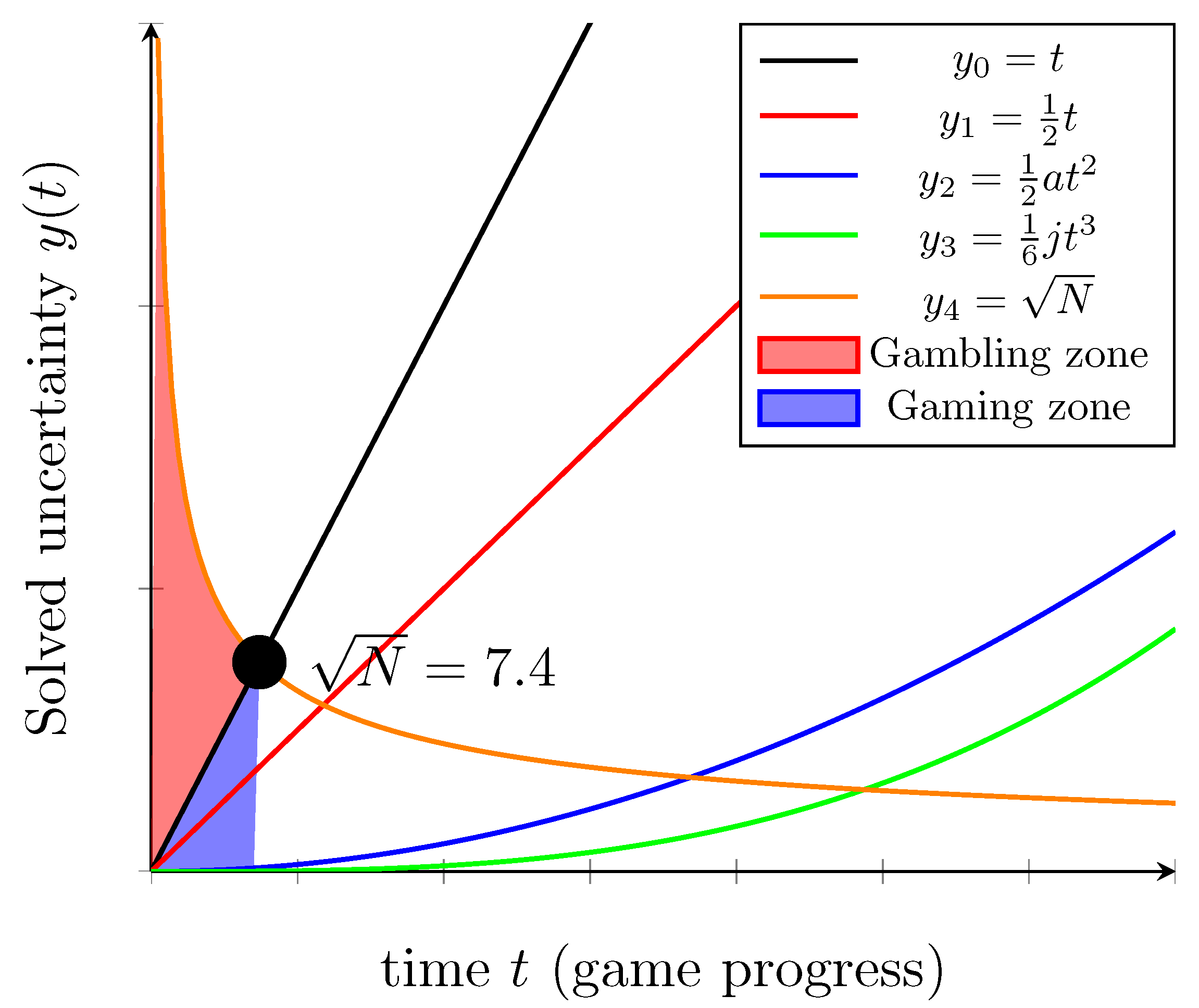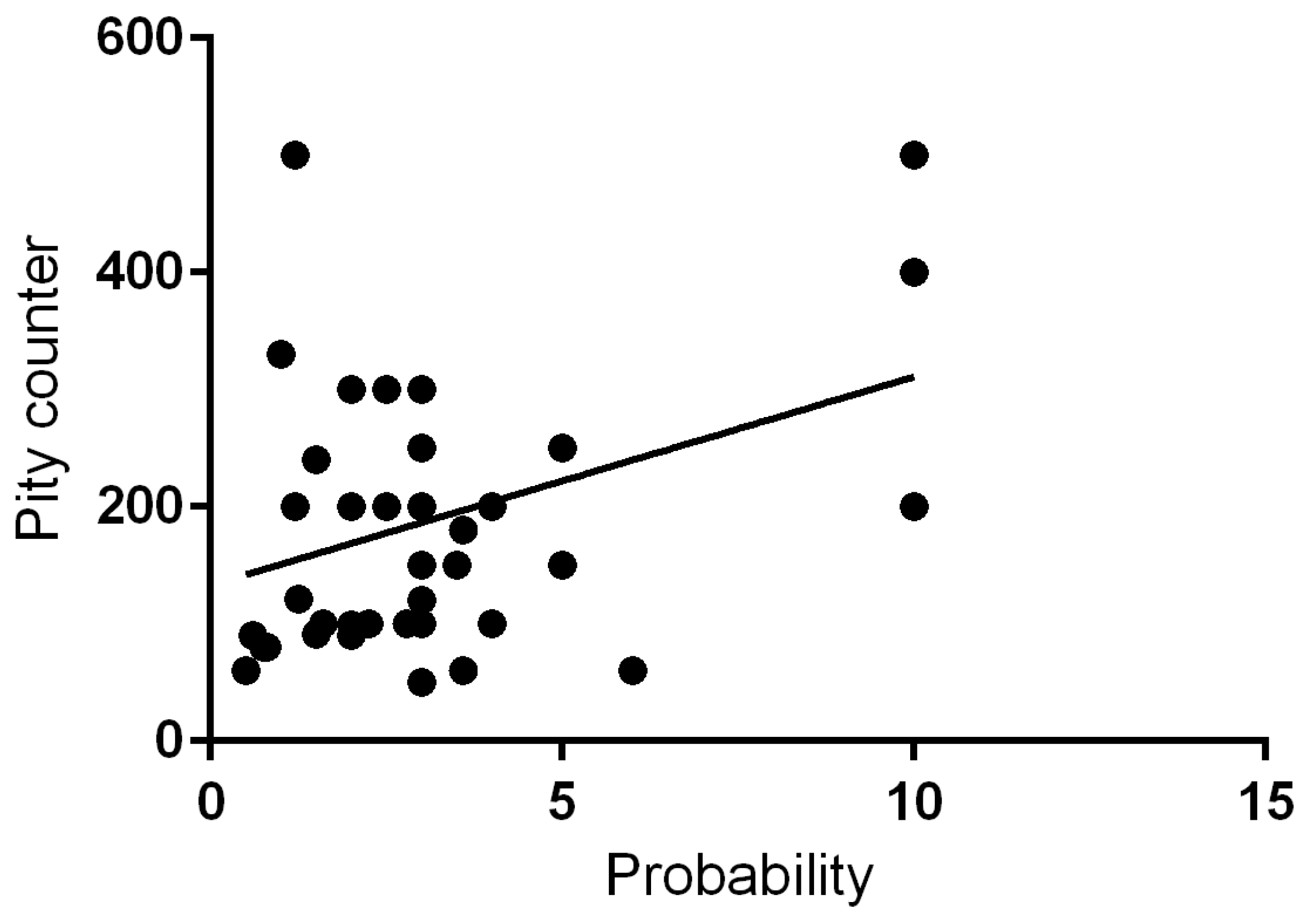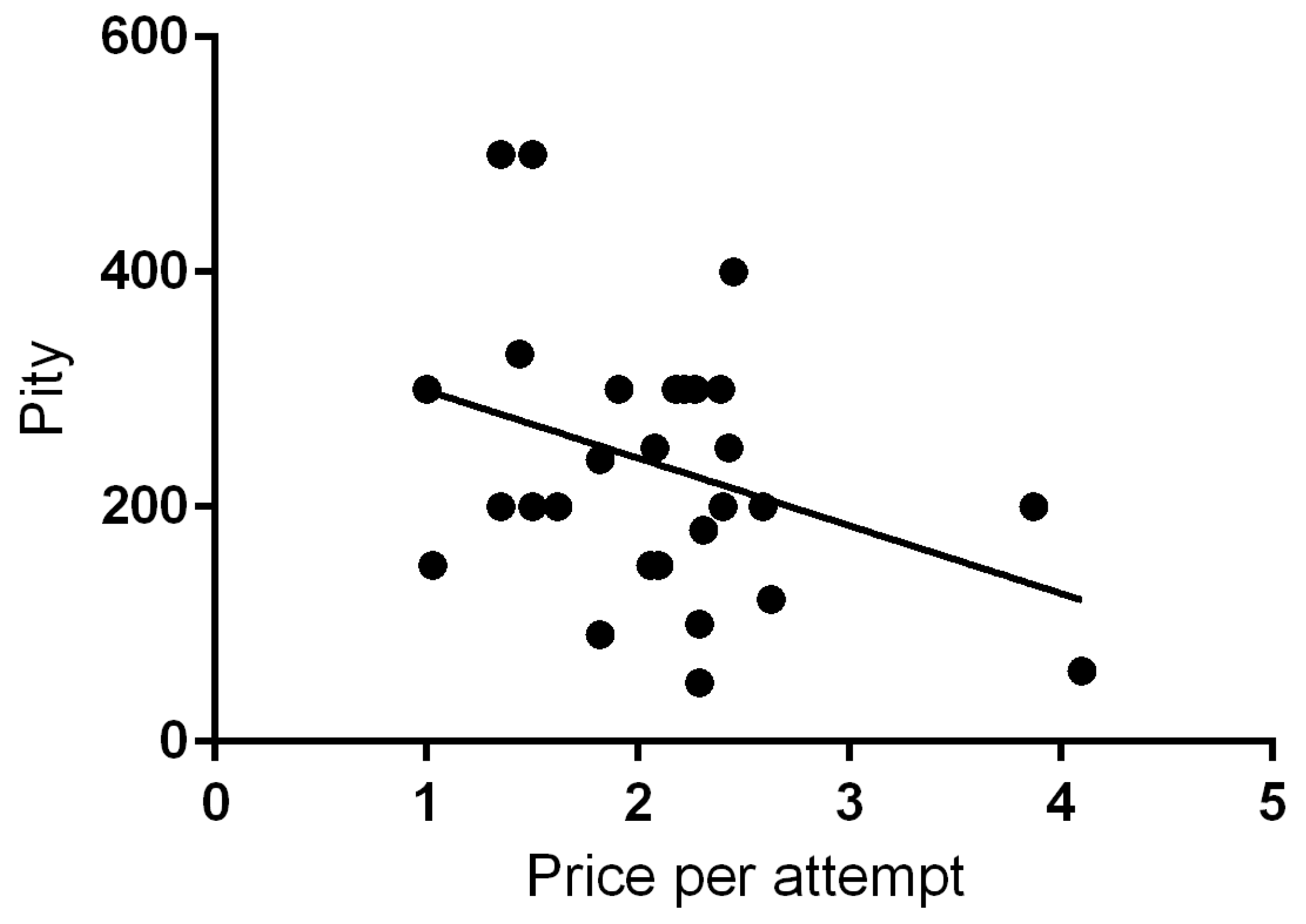Inherent Addiction Mechanisms in Video Games’ Gacha
Abstract
1. Introduction
- Examine how reward frequency influences game attractiveness and player retention in Gacha systems.
- Investigate the role of the ‘pity system’ in shaping player behavior and its contribution to addiction mechanisms.
- Compare Genshin Impact’s Gacha design with other popular titles to evaluate the ethical implications of different pity systems.
2. Research Background
2.1. Background of Gacha in Genshin Impact
2.2. Motion in Mind
- The quantitative structure of Gacha systems (via GR and Motion-in-Mind metrics such as velocity, acceleration, and jerk).
- The psychological reinforcement mechanisms (via variable-ratio reinforcement) that explain why players continue engaging despite uncertain outcomes.
3. Data Collection and Analysis
- To examine how reward frequency (H1) relates to game attractiveness and addictive potential, and
- To assess how the pity system (H2) shifts the balance between engaging gameplay and gambling-like mechanics.
3.1. Practical Interpretation of the Results
- Reward Frequency (N): On average, players in Genshin Impact required ≈61 attempts to obtain a 5-star character. This places the game beyond the hypothesized safe threshold (), indicating gambling-like risk.
- Addictive Measure (AD): Values fell below the ‘comfortable’ range (0.045–0.06), suggesting that the design encourages repeated attempts before satisfaction is achieved, heightening risk of compulsive play.
- Impact of the Pity System: While the pity counter guarantees eventual rewards, it also locks players into extended play cycles, effectively delaying gratification in a way consistent with variable-ratio reinforcement.
3.2. Theoretical Interpretation of the Results
4. Discussion
4.1. Border Between Gaming and Gambling
4.2. Comparing the Pity of Various Other Gacha Games
4.3. Significance of the Number of Attempts
- When , it signifies that the game has to be played N times in order to be confident of the outcome of the game. This is apparent in games of chance, where if the probability of winning the game is 1% (), it would take 100 attempts on average to ensure that you win once. Gacha games implement this where players have to attempt the Gacha for N times until they reach the pity and obtain the rare item, where based on the data collected in Table 1. Hence, games with require at least N attempts to ensure players’ engagement toward the outcome of the game.
- shows the cross point between and happens when . Previous work showed how imperfect information games like Mahjong and Doudizhu have their reward frequencies at 8 and 9, respectively [42]. This cross point shows the scenario of imperfect information games that incorporate chance and skill, contrasting to games of pure chance, as shown in the previous cross point where . Hence, players often time only need to play games with once to be fully engaged and confident throughout the outcome of the game.
- The final cross point shows the scenario for perfect information games like Chess and Go where . These games are more skill-oriented and have less influence by chance compared to the previously listed games. However, to achieve this cross point, players would need to play the game times ( of the game progress), which is harder to imagine compared to the previous two cases. We conjecture that grand-master-level players often can predict the outcome of a game based on the opening moves. As such, we feel that signifies the opening moves of a game in a perfect information skill-based game.
4.4. Limitations and Assumptions
- Dataset Representativeness: The dataset, while substantial (7000 pulls across 12 players), does not cover the full Genshin Impact player population. It is used primarily to test the theoretical framework rather than to provide population-level statistics.
- Use of External Tools: Data was collected using the community-built Genshin Wish Export tool. Although widely adopted and validated by players, it is not an official data source. Minor discrepancies may exist between exported logs and in-game histories.
- Assumptions in Theoretical Frameworks: The application of Game Refinement (GR) Theory and Reinforcement Theory assumes that game addiction mechanisms can be approximated by structural uncertainty and reinforcement schedules. While these frameworks are established in game studies and psychology, they simplify complex player behaviors and may not capture all motivational factors.
- Assumptions of regression: With a limited dataset, some regression assumptions (e.g., residual normality, homoscedasticity, independence) may be violated. Such violations could affect coefficient stability and reduce the reliability of statistical significance. The analysis therefore remains exploratory, highlighting possible structural relationships rather than definitive predictive models.
- Threshold Values: The thresholds identified for distinguishing gaming from gambling (e.g., , ) are derived from a specific dataset and theoretical modeling. They should be interpreted as heuristic indicators rather than universal constants across all Gacha games.
- Regression Analysis: The multiple linear regression results should be interpreted cautiously, as the dataset size limits statistical power. Future work should validate these results with larger, more diverse samples and potentially include variables such as player demographics, session length, and in-game spending.
4.5. Ethical Design and Policy Implications
5. Conclusions
- For game developers, our results provide quantitative thresholds (e.g., reward frequency ) that can guide ethical design of pity systems, ensuring games remain engaging without tipping into gambling-like risk.
- For policymakers, the findings highlight that regulation should not only require odds disclosure but also consider pity system design, which plays a central role in sustaining addictive reinforcement cycles.
- For practitioners in psychology and education, the insights demonstrate how variable-ratio reinforcement in digital games parallels gambling mechanisms, underlining the need for preventive interventions and awareness campaigns.
Author Contributions
Funding
Institutional Review Board Statement
Informed Consent Statement
Data Availability Statement
Acknowledgments
Conflicts of Interest
References
- Rissanen, E. Live Service Games: Changes in Videogame Production. Bachelor’s Thesis, Lab University of Applied Sciences, Lahti, Finland, 2021. [Google Scholar]
- Gan, T. Gacha game: When prospect theory meets optimal pricing. arXiv 2022, arXiv:2208.03602. [Google Scholar]
- Zendle, D.; Meyer, R.; Cairns, P.; Waters, S.; Ballou, N. The prevalence of loot boxes in mobile and desktop games. Addiction 2020, 115, 1768–1772. [Google Scholar] [CrossRef] [PubMed]
- Wong, A.W.T. Analysis of global regulatory schemes on chance-based microtransactions. In Asper Review of International Business and Trade Law; HeinOnline: Getzville, NY, USA, 2019; Volume 19, p. 111. [Google Scholar]
- Diep, C. Retail Value of the Capsules Toys (Gachapon) Market in Japan from Fiscal Year 2016 to 2022. 2022. Available online: https://www.statista.com/statistics/695849/japan-gashapon-market-size/ (accessed on 1 July 2025).
- Low, S. Gacha Gaming—The Good, the Bad, and the Bankrupt. 2023. Available online: https://www.gameshub.com/news/opinions-analysis/gacha-gaming-history-good-bad-bankrupt-genshin-impact-2621770/ (accessed on 1 July 2025).
- Tham, S.M.; Perreault, G.P. A whale of a tale: Gaming disorder and spending and their associations with ad watching in role-playing and loot-box gaming. J. Gambl. Issues 2021, 46, 62–81. [Google Scholar] [CrossRef]
- Churchill, S.A.; Farrell, L. The impact of gambling on depression: New evidence from england and scotland. Econ. Model. 2018, 68, 475–483. [Google Scholar] [CrossRef]
- Latvala, T.; Lintonen, T.; Konu, A. Public health effects of gambling–debate on a conceptual model. BMC Public Health 2019, 19, 1–16. [Google Scholar]
- Adolphe, A.; Khatib, L.; van Golde, C.; Gainsbury, S.M.; Blaszczynski, A. Crime and gambling disorders: A systematic review. J. Gambl. Stud. 2019, 35, 395–414. [Google Scholar] [CrossRef]
- Lind, K.; Kääriäinen, J.; Kuoppamäki, S.M. From problem gambling to crime? findings from the finnish national police information system. J. Gambl. Issues 2015, 30, 98–123. [Google Scholar] [CrossRef]
- Maverick, J.; Kindness, D.; Kvilhaug, S. Why Does the House Always Win? A Look at Casino Profitability. 2022. Available online: https://www.investopedia.com/articles/personal-finance/110415/why-does-house-always-win-look-casino-profitability.asp (accessed on 1 August 2025).
- HoYoverse Genshin Impact. 2020. Available online: https://genshin.hoyoverse.com/en/game (accessed on 1 August 2025).
- Krdzic, H. Dad Gets Money Back After Daughter Spends $20,000 on Genshin Impact Microtransactions. 2020. Available online: https://gamerant.com/dad-money-return-daughter-spends-20000-genshin-impact-microtransactions/ (accessed on 1 August 2025).
- Sahbegovic, A. Genshin Impact Among Most Successful Mobile Games Ever, Having Earned $4 Billion by 2023. 2023. Available online: https://www.sportskeeda.com/esports/news-genshin-impact-among-successful-mobile-games-ever-earned-4-billion-2023 (accessed on 1 August 2025).
- Genshin Impact Official. Future Versions and Events. 2020. Available online: https://www.hoyolab.com/article/38231 (accessed on 1 August 2025).
- freudianeu Sparking in Granblue Fantasy. 2017. Available online: https://freudiagbf.wordpress.com/2017/04/20/sparking/ (accessed on 1 August 2025).
- Nabiilah, N. Genshin Impact: How Much Each 5-Star Constellation Costs (in Cash and Primogems). 2022. Available online: https://gamerant.com/genshin-impact-how-much-five-star-constellation-costs-cash-primogems/ (accessed on 1 August 2025).
- Blaszczynski, A.; Silove, D. Pathological gambling: Forensic issues. Aust. N. Z. J. Psychiatry 1996, 30, 358–369. [Google Scholar] [CrossRef] [PubMed]
- Walker, M.B. Some problems with the concept of “gambling addiction”: Should theories of addiction be generalized to include excessive gambling? J. Gambl. Behav. 1989, 5, 179–200. [Google Scholar] [CrossRef]
- Lesieur, H.R.; Custer, R.L. Pathological gambling: Roots, phases, and treatment. Ann. Am. Acad. Political Soc. Sci. 1984, 474, 146–156. [Google Scholar]
- Abarbanel, B.; Gainsbury, S.M.; King, D.; Hing, N.; Delfabbro, P.H. Gambling games on social platforms: How do advertisements for social casino games target young adults? Policy Internet 2017, 9, 184–209. [Google Scholar] [CrossRef]
- Elhai, J.D.; Yang, H.; Montag, C. Fear of missing out (fomo): Overview, theoretical underpinnings, and literature review on relations with severity of negative affectivity and problematic technology use. Braz. J. Psychiatry 2020, 43, 203–209. [Google Scholar] [CrossRef]
- Alutaybi, A.; Al-Thani, D.; McAlaney, J.; Ali, R. Combating fear of missing out (fomo) on social media: The fomo-r method. Int. J. Environ. Res. Public Health 2020, 17, 6128. [Google Scholar] [CrossRef]
- Heinisuo, H. Gacha Monetization Mechanics: Customizable Simulator for Random Draws. Master’s Thesis, Tampere University, Tampere, Finland, 2022. [Google Scholar]
- Svetlík, T. Diablo immortal. Acta Ludologica 2022, 5, 112–115. [Google Scholar]
- Hexacoto. The Psychology of Being a Completionist. 2010. Available online: https://hexacoto.com/2014/01/01/the-psychology-of-being-a-completionist/ (accessed on 1 August 2025).
- Clinic, M. Hoarding Disorder. 2023. Available online: https://www.mayoclinic.org/diseases-conditions/hoarding-disorder/symptoms-causes/syc-20356056 (accessed on 1 August 2025).
- Mataix-Cols, D. Hoarding disorder. N. Engl. J. Med. 2014, 370, 2023–2030. [Google Scholar] [CrossRef]
- George-Gabriel, R.; Anastasia, K. What Aspects of Gacha Games Keep the Players Engaged? 2022. Available online: https://www.diva-portal.org/smash/record.jsf?pid=diva2%3A1665022&dswid=1584 (accessed on 1 August 2025).
- Thomas, J. How to Get a 5-Star Banner Weapon to Refinement Rank 5 in Genshin Impact. 2022. Available online: https://progameguides.com/genshin-impact/how-to-get-a-5-star-banner-weapon-to-refinement-rank-5-in-genshin-impact/ (accessed on 1 August 2025).
- Hoyolab. Character Archive. 2023. Available online: https://wiki.hoyolab.com/pc/genshin/aggregate/character (accessed on 1 August 2025).
- Barberis, N.C. Thirty years of prospect theory in economics: A review and assessment. J. Econ. Perspect. 2013, 27, 173–196. [Google Scholar] [CrossRef]
- Kahneman, D.; Tversky, A. Prospect theory: An analysis of decision under risk. In Handbook of the Fundamentals of Financial Decision Making: Part I; World Scientific: Singapore, 2013; pp. 99–127. [Google Scholar]
- Torgerson, D.J.; Raftery, J. Discounting. BMJ 1999, 319, 914–915. [Google Scholar] [CrossRef]
- HoYoverse. Genshin Impact Homepage. 2023. Available online: https://genshin.hoyoverse.com/en/ (accessed on 1 August 2025).
- Adams, M.J. Tech otakus save the world? gacha, genshin impact, and cybernesis. Br. J. Chin. Stud. 2022, 12, 188–208. [Google Scholar] [CrossRef]
- Jėčius, D.; Frestadius, A. How Do Players Experience a Gacha Game Depending on Their Perspective as a Starting or a Veteran Player?: A Case Study of Genshin Impact. 2022. Available online: http://www.diva-portal.org/smash/record.jsf?pid=diva2%3A1669147&dswid=-9401 (accessed on 1 August 2025).
- Wiki, G.I.W.G. Gacha Pull Rates and In-App Purchases. 2024. Available online: https://game8.co/games/Genshin-Impact/archives/297443 (accessed on 1 August 2025).
- Sutiono, A.P.; Purwarianti, A.; Iida, H. A mathematical model of game refinement. In International Conference on Intelligent Technologies for Interactive Entertainment; Springer: Berlin/Heidelberg, Germany, 2014; pp. 148–151. [Google Scholar]
- Iida, H.; Khalid, M.N.A. A paradigm shift from optimal play to mental comfort: A perspective from the game refinement theory. Int. J. Informa. Inf. Syst. Comput. Eng. (INJIISCOM) 2020, 1, 47–78. [Google Scholar] [CrossRef]
- Gao, N.; Chang, H.; Zhang, Z.; Khalid, M.N.A.; Iida, H. Implications of jerk’s on the measure of game’s entertainment: Discovering potentially addictive games. IEEE Access 2022, 10, 134362–134376. [Google Scholar] [CrossRef]
- Gao, N.; Gao, Y.; Khalid, M.N.A.; Iida, H. A computational game experience analysis via game refinement theory. Telemat. Inform. Rep. 2023, 9, 100039. [Google Scholar]
- Ferster, C.B.; Skinner, B.F. Schedules of Reinforcement; Appleton-Century-Crofts: New York, NY, USA, 1957. [Google Scholar]
- Iida, H.; Khalid, M.N.A. Using games to study law of motions in mind. IEEE Access 2020, 8, 138701–138709. [Google Scholar] [CrossRef]
- Zola, A. Reinforcement Theory. 2022. Available online: https://www.techtarget.com/whatis/definition/reinforcement-theory (accessed on 1 August 2025).
- Sztainert, T. Loot Boxes and Gambling; Gambling Research Exchange Ontario: Guelph, ON, Canada, 2018; Volume 20. [Google Scholar]
- Kang, X.; Khalid, M.N.A.; Iida, H. Player satisfaction model and its implication to cultural change. IEEE Access 2020, 8, 184375–184382. [Google Scholar] [CrossRef]
- Zhang, Z.; Xiaohan, K.; Khalid, M.N.A.; Iida, H. Bridging ride and play comfort. Information 2021, 12, 119. [Google Scholar] [CrossRef]
- Eager, D. G-force and the enjoyment of rides. Australas. Park. Leis. 2013, 16, 32–34. [Google Scholar]
- Pendrill, A.M.; Eager, D. Velocity, acceleration, jerk, snap and vibration: Forces in our bodies during a roller coaster ride. Phys. Educ. 2020, 55, 065012. [Google Scholar] [CrossRef]
- Alha, K.; Koskinen, E.; Paavilainen, J.; Hamari, J.; Kinnunen, J. Free-to-play games: Professionals’ perspective. In Proceedings of DiGRA Nordic 2014; DiGRA: Tampere, Finland, 2014. [Google Scholar]
- Wiki, A.S. Limited-Time Recruitment. 2024. Available online: https://alchemystars.fandom.com/wiki/Limited-Time_Recruitment (accessed on 1 August 2025).
- Vivians, K. 10 Popular Gacha Games That Got Shut Down. 2023. Available online: https://www.cbr.com/gacha-games-that-ended/ (accessed on 1 August 2025).







| Banner | Wish Events | ||
|---|---|---|---|
| Type | Character | Weapon | Permanent |
| Pulls Made | 4632 | 1793 | 662 |
| Pity counter | 90 | 80 | 90 |
| 5-star | 75 (1.6%) | 35 (2.0%) | 11 (1.7%) |
| 4-star | 608 (13.1%) | 267 (14.9%) | 81 (12.2%) |
| 3-star | 3949 (85.3%) | 1491 (83.2%) | 570 (86.1%) |
| Average N | 61.5 | 51.11 | 57.1 |
| G | T | v | m | GR | AD | |
|---|---|---|---|---|---|---|
| Average | 1 | 61.50 | 0.016 | 0.984 | 0.023 | 0.030 |
| Luckiest | 1 | 5.00 | 0.200 | 0.800 | 0.283 | 0.363 |
| Unluckiest | 1 | 83.00 | 0.012 | 0.988 | 0.017 | 0.022 |
| Best-case | 1 | 1 | 1 | 0 | 1.41 | 1.817 |
| Worst-case | 1 | 90.00 | 0.011 | 0.989 | 0.016 | 0.020 |
| Game | Probability in % | Price in USD | Pity Counter |
|---|---|---|---|
| Alchemy Stars ★ | 2.00 | 2.86 | 90 |
| Arknights ★ | 2.00 | 1.80 | 99 |
| Bang Dream ★ | 3.00 | 2.27 | 50 |
| Cookie Run: Kingdom (Epic) ★ | 2.80 | 1.92 | 100 |
| Dragalia Lost ★ | 4.00 | 2.29 | 100 |
| Dragalia Lost Gala ★ | 6.00 | 2.29 | 60 |
| Fire Emblem Heroes ★ | 3.00 | 2.14 | 120 |
| Genshin Impact ★ | 0.60 | 1.98 | 90 |
| Girls Frontline: Neural Cloud ★ | 3.60 | 2.31 | 60 |
| Honkai Impact 3rd ★ | 2.25 | 3.46 | 100 |
| Honkai Star Rail ★ | 0.60 | 1.98 | 90 |
| Tears of Themis ★ | 1.60 | 2.23 | 100 |
| Tower of Fantasy ★ | 0.75 | 1.93 | 80 |
| Wuthering Waves ★ | 0.80 | 1.98 | 80 |
| Azur Lane † | 1.20 | 1.35 | 200 |
| Counter:Side † | 3.50 | 1.03 | 150 |
| Dangeki Bunko: Crossing Void † | 1.50 | 1.82 | 91 |
| Epic Seven † | 1.25 | 2.63 | 121 |
| Fate/Grand Order † | 1.00 | 1.44 | 330 |
| Girls Frontline: Neural Cloud † | 3.60 | 2.31 | 180 |
| Punishing Gray Raven † | 0.50 | 4.10 | 60 |
| Alice Fiction ‡ | 2.50 | 2.40 | 200 |
| Azur Lane ‡ | 1.20 | 1.35 | 500 |
| Bang Dream ‡ | 3.00 | 2.27 | 300 |
| Blue Archive ‡ | 3.00 | 1.62 | 200 |
| Dangeki Bunko: Crossing Void ‡ | 1.50 | 1.82 | 240 |
| Dissidia Final Fantasy ‡ | 5.00 | 2.06 | 150 |
| Dragon Ball Z: Dokkan Battle ‡ | 10.00 | 1.50 | 500 |
| Dragon Ball Z: Dokkan Battle ‡ v2 | 10.00 | 1.50 | 200 |
| Granblue Fantasy ‡ | 3.00 | 1.00 | 300 |
| Guardian Tales ‡ | 2.00 | 1.91 | 300 |
| Hatsune Miku Colorful Stage Free ‡ | 3.00 | 2.29 | 100 |
| Hatsune Miku Colorful Stage Paid ‡ | 3.00 | 2.29 | 50 |
| Idolmaster Cinderella Girls Starlight Stage ‡ | 3.00 | 2.22 | 300 |
| Idolmaster Million Live ‡ | 3.00 | 2.22 | 300 |
| Idolmaster Shiny Colors ‡ | 2.00 | 2.39 | 300 |
| Love Live School Idol Festival 2 ‡ | 3.00 | 2.08 | 250 |
| Love Live SIF Allstars ‡ | 5.00 | 2.43 | 250 |
| Nier Reincarnation ‡ | 2.00 | 2.59 | 200 |
| Nikke ‡ | 4.00 | 3.87 | 200 |
| Pokemon Masters EX ‡ | 10.00 | 2.45 | 400 |
| Princess Connect! Re:Dive ‡ | 2.50 | 2.18 | 300 |
| SinoAlice ‡ | 3.00 | 2.10 | 150 |
Disclaimer/Publisher’s Note: The statements, opinions and data contained in all publications are solely those of the individual author(s) and contributor(s) and not of MDPI and/or the editor(s). MDPI and/or the editor(s) disclaim responsibility for any injury to people or property resulting from any ideas, methods, instructions or products referred to in the content. |
© 2025 by the authors. Licensee MDPI, Basel, Switzerland. This article is an open access article distributed under the terms and conditions of the Creative Commons Attribution (CC BY) license (https://creativecommons.org/licenses/by/4.0/).
Share and Cite
Thavamuni, S.; Khalid, M.N.A.; Iida, H. Inherent Addiction Mechanisms in Video Games’ Gacha. Information 2025, 16, 890. https://doi.org/10.3390/info16100890
Thavamuni S, Khalid MNA, Iida H. Inherent Addiction Mechanisms in Video Games’ Gacha. Information. 2025; 16(10):890. https://doi.org/10.3390/info16100890
Chicago/Turabian StyleThavamuni, Sagguneswaraan, Mohd Nor Akmal Khalid, and Hiroyuki Iida. 2025. "Inherent Addiction Mechanisms in Video Games’ Gacha" Information 16, no. 10: 890. https://doi.org/10.3390/info16100890
APA StyleThavamuni, S., Khalid, M. N. A., & Iida, H. (2025). Inherent Addiction Mechanisms in Video Games’ Gacha. Information, 16(10), 890. https://doi.org/10.3390/info16100890










